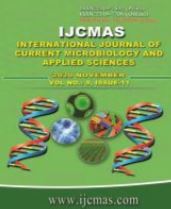


 National Academy of Agricultural Sciences (NAAS)
National Academy of Agricultural Sciences (NAAS)

|
PRINT ISSN : 2319-7692
Online ISSN : 2319-7706 Issues : 12 per year Publisher : Excellent Publishers Email : editorijcmas@gmail.com / submit@ijcmas.com Editor-in-chief: Dr.M.Prakash Index Copernicus ICV 2018: 95.39 NAAS RATING 2020: 5.38 |
Water retting of whole jute (Corchorus olitorius L.) plant is convenient to the majority of farmers. Jute bundles are extensively retted in isolated stagnant inland freshwater bodies, often having insufficient water, during the months of August–October in the Indo-Bangla subcontinent. It leads to transportation expense, improper retting with low fibre quality, complete loss of huge organic retting residue and transitory deterioration of the aquatic environment affecting local ecology. Water scarcity due to climate change has aggravated jute retting. This article details a comprehensive retting technology where1-1.35 m deep circular or rectangular lined (tarpaulin/silpaulin) or unlined (in clay soil) micro-pond of area 80 (i.e., 2 decimal) is sufficient for retting a jute plot of 0.135 ha and that of 130 (i.e., 3.5 decimal) for 0.340 ha harvest area, in a batch. Staggered jute sowing or harvesting at 10-15 days’ interval enables two more successive batch rettings in a pond with shorter retting time and improved fibre quality. Water requirement in it is only 43 l kg-1 of good quality fibre, compared to 693 l kg-1 in traditional retting. It is suitable primarily for small and marginal land holdings. Also described modifications on local retting methods addressing practical difficulties. Demonstrations at farmers’ field of this technology held regularly since 2009 found its higher acceptability. Using ground water or rainwater under deficit rainfall, it produced desired golden coloured and lustrous fibre in 15-30 days in a hygienic extraction setting. It abolished usual labour requirement of 30 man-days ha-1 or more to carry jute bundles to distant retting spots. In a micro-pond of 2 decimal area for retting 1 acre jute, with an initial investment of Rs 15900, its benefit-cost ratio is envisaged at 1.28:1, signifying a substantial economic return in the course of 5 five years. In a new integrated farming system (IFS) model, it sustained jute retting in low volume water, strengthened farm income from improved fibre quality, conserved organic manure (10-15 bags per year), diversified production by optimizing resource use in the production of rice, vegetables and fish and reduced environmental pressure. Additionally, a well-developed network of these tanks can support to improve groundwater recharge, provide lifesaving irrigations, save crops from early water logging stress and in-situ composting of agricultural residues during dry months.
 |
 |
 |
 |
 |